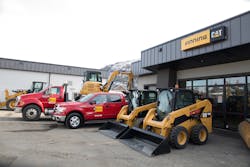Finning Revenue Declines 21 Percent Year over Year in Q3, But Jumps 8 Percent from Q2
Western Canada Caterpillar dealer Finning, one of the world’s largest Caterpillar dealers, posted third quarter revenue of CDN $1.6 billion and net revenue of $1.4 billion, down 21 percent from the third quarter of 2019, reflecting reduced market activity in Canada and South America. However, compared to the second quarter, when the COVID-19 pandemic hit especially hard, net revenue was up 8 percent, driven by a recovering market in the U.K. and Ireland and modest market improvements in Canada and South America.
Third quarter 2020 gross profit was 15 percent lower than in the third quarter of 2019. Gross profit as a percentage of revenue was 27 percent in Q320, 120 basis points higher than in the third quarter of 2019, primarily because of a revenue mix shift to product support revenue.
SG&A costs decreased by 13 percent, or $43 million, from Q3 2019 and by 5 percent, or $16 million, from Q2 2020, reflecting successful execution of global productivity initiatives and tight cost control. Finning said it is on track to deliver more than $100 million of annualized cost savings.
Improved execution and cost actions in South America resulted in EBIT as a percentage of net revenue of 8.2 percent in Q3 2020, the highest since Q2 2018. In Canada, a reduced cost structure drove improved profitability from Q2 2020 in a slow recovery environment. UK & Ireland achieved strong Q3 2020 results, underpinned by recovering product support and continued cost discipline.
“I am very proud of how our organization has operated safely, served our customers, and executed on our strategic priorities in a very dynamic operating environment,” said Scot Thomson, Finning International president and CEO. “Our strong results in the third quarter are a reflection of how we have delivered on the commitments we set out at the beginning of the year to improve execution in South America, lower our cost base in Canada, position the U.K. for High Speed Rail 2 opportunities, and reduce our finance costs. We saw some sequential end market improvements in the third quarter of 2020, particularly in rental and product support activity as customers resumed work and machine utilization hours increased. We expect most of our markets to continue to improve in Q4 2020 and into 2021 as mining trucks have gone back to work, strengthened copper prices are supporting recovery and growth in activity, and government stimulus spending supports large infrastructure projects.
“Going forward, we are focused on growing product support revenue through the market recovery by strengthening relationships with customers and leveraging technology. Recovering volumes, combined with our productivity initiatives throughout the organization, support our mid-cycle target for SG&A as a percentage of net revenue of 17 percent. Our overall outlook for the balance of 2020 and into 2021 remains positive.”
Although Finning Canada’s rental revenue fell 24 percent compared with the third quarter of 2019, a rebound in rental activity and utilization led to a 40 percent increase in rental revenue from Q2 20 to Q320. Net revenue decreased by 26 percent in Canada with lower revenue across all sectors and lines of business, reflecting challenging market conditions related to COVID-19 and the lower price of oil.
New equipment sales were down 51 percent as customers reduced activity, restricted capital spending, and implemented cost containment measures. By contrast, Q3 2019 benefitted from deliveries of large mining equipment packages. Product support revenue declined by 11 percent from Q3 2019, however, it increased by 4 percent compared to Q2 2020. Oil sands producers’ truck fleet utilization returned to pre-COVID-19 levels at the end of September, approximately one month later than expected due to certain operational challenges at customer sites. In the construction sector, equipment utilization hours increased, driving improved demand for parts and service compared to Q2 2020.
In construction, continued recovery in machine utilization hours and rental utilization are expected to drive improved demand for product support and rentals. Large infrastructure programs are planned in Alberta, British Columbia and Saskatchewan. Additional infrastructure stimulus spending announced by the federal and provincial governments is expected to provide opportunities for equipment, product support, heavy rentals, and prime and standby electric power generation in 2021.
While Finning has seen an increase in order intake for construction equipment, it expect the pricing environment to remain highly competitive in the near term because of a surplus of competitive equipment inventories in Western Canada.
Finning expects improved profitability in Canada in 2021 even in a modest revenue recovery environment. Headquartered in Vancouver, B.C., Finning operates in Western Canada, Chile, Argentina, Bolivia, the United Kingdom and Ireland.
About the Author
Michael Roth
Editor
Michael Roth has covered the equipment rental industry full time for RER since 1989 and has served as the magazine’s editor in chief since 1994. He has nearly 30 years experience as a professional journalist. Roth has visited hundreds of rental centers and industry manufacturers, written hundreds of feature stories for RER and thousands of news stories for the magazine and its electronic newsletter RER Reports. Roth has interviewed leading executives for most of the industry’s largest rental companies and manufacturers as well as hundreds of smaller independent companies. He has visited with and reported on rental companies and manufacturers in Europe, Central America and Asia as well as Mexico, Canada and the United States. Roth was co-founder of RER Reports, the industry’s first weekly newsletter, which began as a fax newsletter in 1996, and later became an online newsletter. Roth has spoken at conventions sponsored by the American Rental Association, Associated Equipment Distributors, California Rental Association and other industry events and has spoken before industry groups in several countries. He lives and works in Los Angeles when he’s not traveling to cover industry events.
